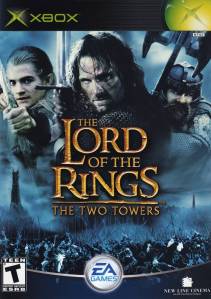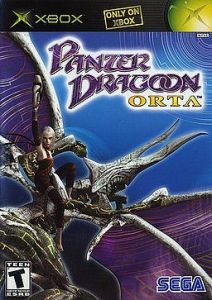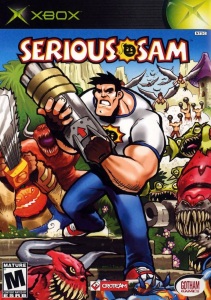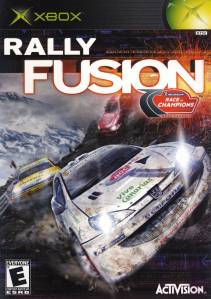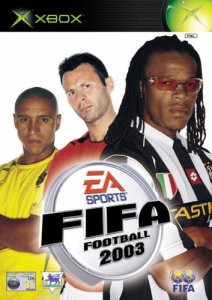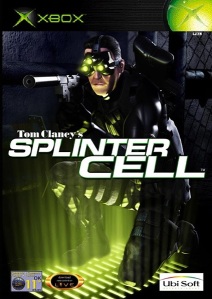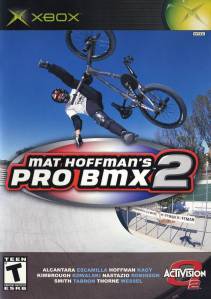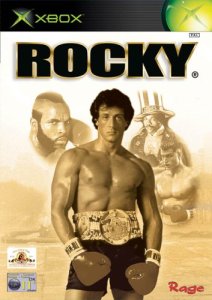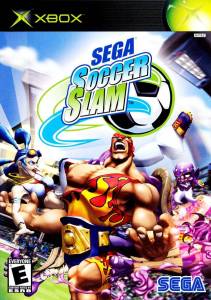Gamestyle Archive Intro: slightly incomplete review this one, but I think its just the last line or few words, therefore felt best to release it online once again. Here Alex goes all dwarf and Tolkien on us with the Xbox version of the game. This review dates from October 2002, my goodness that’s almost 14 years ago!
Who else could have managed to afford what is currently one of the hottest film licenses in existance, if not Electronic Arts? Peter Jackson’s film trilogy adaptation of J. R. R. Tolkien’s Lord of the Rings is hot property, and rightly so – few can argue that he hasn’t managed to capture the essence of the tale quite beautifully and delicately – and whilst EA weren’t quick enough to get a videogame out based on the first tale alone, they’ve settled for using the best action-based sequences from both The Fellowship of the Ring and The Two Towers; the marketing department clearly deciding that naming the game after the most current episode in the threesome would be most commercially rewarding.
So, the Stormfront produced title features what EA felt were the areas of the pictures that would translate best to the style of game they were developing; namely an action beat-em-up. This is in direct contrast to the Vivendi published game (on all formats) based squarely around Tolkien’s original books, which is much more of an action/adventure game that does not possess the New Line license, and so relies more on story-telling and character building. EA’s Lord of the Rings game does not attempt to tell a coherent story, or develop any characters (aside from some rudimentary RPG-lite levelling up) and instead opts for a disappointingly linear Gauntlet style affair, yet reduces what made Gauntlet enjoyable by stripping any notion of multiple players completely away – sure, you might very well be fighting alongside AI-driven Fellowship members, but there’s no substitute for some good old fashioned co-operative gaming (see the console versions of Baldurs Gate).
The Two Towers, then, is a small selection of levels based (fairly accurately) around the likes of Weathertop, Moria and (obviously) Helm’s Deep. However, on first booting the disk you’re first forced to watch through the prologue, taken directly from the first film’s introduction (but raped of the glorious anamorphic widescreen mode, both in pre-rendered and realtime graphics). The Battle of The Last Alliance looks good, still, but you’ve seen it all before; at least, that is, until the bit you don’t quite remember. It’s here that you realise what Stormfront have just done – they’ve melded the movie footage directly into the game – there’s a brief second before you work out what’s happening and then it clicks – you’re suddenly in control of Isildur, and there’s hundreds of orcs all around you.
Impressive? At first. Sadly your movement is severly restricted (a theme that’s continued throughout the other levels) and you can’t really die as it’s just an introduction, so you’re left mashing the buttons trying to work out what does what, and why. It looks great though, in a kind of Dynasty Warriors way, with lots of poorly AI’d friends and foe running about like 5 year olds playing football. Anyway, after Sauron appears and the game blends back into the film footage, it’s fast forward to Weathertop, and you’re placed in control of Aragorn against the Nasgul. Again, it’s a very small play area, and the combat is, at this stage, incredibly basic. It’s only after Weathertop that you begin to accumulate experience points (which can be used to buy new moves and a larger health bar) and therefore level up your character, because from now on you can select between the aforementioned ranger; Legolas the elf, or Gimli the dwarf. They play on the standard balanced player characters often seen in games like this – Legolas has good speed, excellent ranged skills, but is poor with close combat and his defense is lower than the others. Gimli, predictably, is great with his axe, and hard as nails, but is next to useless with his throwing action; Aragorn sits somewhere inbetween and is the safest option for the first play through (the game rewards those who obtain level 10 with all 3 characters).
The later stages do try to offer larger play areas, although Balin’s Tomb in Moria reverts back to the one room ethos used earlier in the game, although to be fair it does work in that particular instance – there’s just something enjoyable about being trapped in a room with all the Fellowship being sieged by hundreds of orcs, even if the obvious level boss is somewhat dull in it’s delivery. Don’t be fooled into thinking that the bigger stages offer a free-roaming aspect, though, you’re led down one path, through enemies that are always in the same place each run through and trigger exactly the same pre-set events, and for the most part are despatched in exactly the same way.
Some repetition is avoided, however, as EA have thankfully allowed the gamer to restart at the level boss rather than at the very beginning of the level should the likes of the Watcher in the Water or Lurtz finish you off. I’d be surprised if they did more than once, though, the patterns are boring, predictable and somewhat an insult to the intelligence of the gamers the software is aimed at. The movie-fabricated Uruc-hai in-particular can be beaten by simply hiding behind a pillar and then using your fierce attack move (Y on the controller, as opposed to A which is a quick attack) when his blade is stuck in the rock. Some respite to the repetition can be garnered from the moves you can ‘purchase’ between levels – these take the form of button combos and holding down various charged moves, but there’s also improvements to your ranged attacks (barbed arrows being the first) and larger health bars. It’s not much, but it does offer at least a reason to replay the levels so you can attempt to collect them all.
Once you’ve reached the end of the game, which will take about 3 hours per character, there’s one bonus mission and a not-so-secret character, and that’s where the fun ends. There’s no backstory, no run-down of the Fellowship or even a map (whilst the Vivendi title had all these) and whilst there are a number of interviews and concept art, they pale into insignificance alongside those found on the various DVDs of the films available. This reviewer hasn’t seen or played the original Playstation 2 version of the game (of which this Xbox version is a direct port) so I can’t comment on how improved the graphics are in comparison; visually it’s somewhat of a mixed bag – half of the characters look great, half look nothing like their on-screen counterparts; animation is rudimentary and very fragmented, and most of the enemies are identikit models, something Jackson strove hard to avoid.
That said, those levels in the game that received most care and attention look great, and the climatic scenes are definately impressive, despite never really showing more than a few moving models on screen at once. Most of the feeling of immersion is handled aurally, though, and it’s here that the license has paid off the best – the characters are all voiced by the original actors, the score is intact and highly effective, and in Dolby Digital 5.1 the effect is quite unlike any similar game – through one sense at least, you really do feel you’re in the film.
Ultimately, though, EA seem to have missed the point slightly. There’s an overwhelming feeling that the movies have been bastardised into something they’re not – there’s no delicacy, there’s no flow between areas and the story telling is reduced to 5 section (badly) pre-rendered sections where the original film footage does not stretch. At the end of the day, you could buy the Extended DVD for the Fellowship and watch the second film a few times for the price of the game, something I’d much rather recommend. By all means rent the game if you wish, play through it then forget about it, but for (text ends)
Gamestyle Score: 5/10
